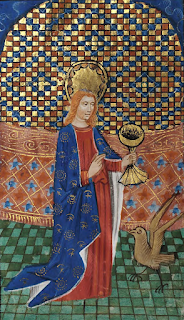When Herod saw that he had been tricked by the wise men, he was infuriated, and he sent and killed all the children in and around Bethlehem who were two years old or under, according to the time that he had learned from the wise men. Then was fulfilled what had been spoken through the prophet Jeremiah:
“A voice was heard in Ramah,
wailing and loud lamentation,
Rachel weeping for her children;
she refused to be consoled, because they are no more."
wailing and loud lamentation,
Rachel weeping for her children;
she refused to be consoled, because they are no more."
Matthew 2;16-18 (NRSV)
The arrangement of the Church’s liturgical calendar is not always intended to be in chronological order. Sometimes feast days are arranged by theological significance.
In this case, there are a slew of feast days right after Christmas that emphasize the fact that the events surrounding Christmas were an anticipation of Christ’s eventual passion, death, and resurrection. On December 26 is the feast of St. Stephen Protomartyr the first Christian martyr after the establishment of the Church. December 27 is the feast of Sr. John the Evangelist the Beloved Disciple who stood at the foot of the Cross and received the Blessed Mother from Christ to be his own Mother. December 29 is the feast of St. Thomas Becket, bishop and martyr. In the midst of this is December 28, the feast of the Holy Innocents, the first martyrs after the birth of Christ.
In short, the Church’s placement of a slew of martyrs’ feast days right after Christmas is intended to remind Catholics that Christ was, as Bishop Fulton Sheen once pointed out, the only man born to die. Christmas is important because it made possible Easter.
While Matthew's gospel is the only source for the Massacre of the Innocents, historian Thomas Madden points out that such a slaughter would have been consistent with what we know about Herod the Great, the king of Judea. Even though Herod was "king of the Jews," though under Roman oversight, many did not consider him Jewish, because his mother, Cypros, was the daughter of an Arab sheik, and thus a Gentile. Jewishness, then as now, was matrilineal. His father was an Idumean--someone who was considered racially impure by many Jews.
Herod, perhaps because of his questionable parentage, went out of his way to direct Roman wealth to his domain, engaging in numerous building projects, including the rebuilding of the Temple, new walls around the city of Jerusalem, the port city of Caesarea. But these projects cost money, and his high taxation made him hugely unpopular--he hired mercenaries and maintained what amounted to a secret police to prevent rebellion. And he placed a golden statue of an eagle--a symbol of Rome and a violation of the Commandment against graven images--atop the gate of the new Temple. When two popular teachers, Judas and Matthias, persuaded their pupils to take down the eagle, Herod had teachers and students burned alive.
The story of the Holy Innocents may not be literally true, but it's certainly in keeping with Herod. Matthew, who was writing to a Jewish audience, has the Holy Family flee to Egypt, in a reversal of Moses' flight from Egypt. After Herod's death, the family returns not to Bethlehem, but to Nazareth.
But surely Matthew is also reminding us that life isn't fair--that in the human realm, those in power will commit enormities to maintain their power. One can hardly look at the last hundred years to find countless examples of the massacre of innocents in the name of power, prejudice, and fear.
As Michelle Arnold explains, the Day of the Holy Innocents is one of "a slew of martyr's feasts right after Christmas" to remind us that Christmas leads inevitably to Golgotha and to Easter.
Image: Pieter Brueghel the Elder, Massacre of the Innocents
+
While Matthew's gospel is the only source for the Massacre of the Innocents, historian Thomas Madden points out that such a slaughter would have been consistent with what we know about Herod the Great, the king of Judea. Even though Herod was "king of the Jews," though under Roman oversight, many did not consider him Jewish, because his mother, Cypros, was the daughter of an Arab sheik, and thus a Gentile. Jewishness, then as now, was matrilineal. His father was an Idumean--someone who was considered racially impure by many Jews.
Herod, perhaps because of his questionable parentage, went out of his way to direct Roman wealth to his domain, engaging in numerous building projects, including the rebuilding of the Temple, new walls around the city of Jerusalem, the port city of Caesarea. But these projects cost money, and his high taxation made him hugely unpopular--he hired mercenaries and maintained what amounted to a secret police to prevent rebellion. And he placed a golden statue of an eagle--a symbol of Rome and a violation of the Commandment against graven images--atop the gate of the new Temple. When two popular teachers, Judas and Matthias, persuaded their pupils to take down the eagle, Herod had teachers and students burned alive.
The story of the Holy Innocents may not be literally true, but it's certainly in keeping with Herod. Matthew, who was writing to a Jewish audience, has the Holy Family flee to Egypt, in a reversal of Moses' flight from Egypt. After Herod's death, the family returns not to Bethlehem, but to Nazareth.
But surely Matthew is also reminding us that life isn't fair--that in the human realm, those in power will commit enormities to maintain their power. One can hardly look at the last hundred years to find countless examples of the massacre of innocents in the name of power, prejudice, and fear.
As Michelle Arnold explains, the Day of the Holy Innocents is one of "a slew of martyr's feasts right after Christmas" to remind us that Christmas leads inevitably to Golgotha and to Easter.
Image: Pieter Brueghel the Elder, Massacre of the Innocents
+



